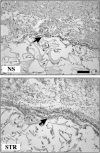Stress-induced enhancement of leukocyte trafficking into sites of surgery or immune activation
- PMID: 15817686
- PMCID: PMC556309
- DOI: 10.1073/pnas.0501650102
Stress-induced enhancement of leukocyte trafficking into sites of surgery or immune activation
Abstract
Effective immunoprotection requires rapid recruitment of leukocytes into sites of surgery, wounding, infection, or vaccination. In contrast to immunosuppressive chronic stressors, short-term acute stressors have immunoenhancing effects. Here, we quantify leukocyte infiltration within a surgical sponge to elucidate the kinetics, magnitude, subpopulation, and chemoattractant specificity of an acute stress-induced increase in leukocyte trafficking to a site of immune activation. Mice acutely stressed before sponge implantation showed 200-300% higher neutrophil, macrophage, natural killer cell, and T cell infiltration than did nonstressed animals. We also quantified the effects of acute stress on lymphotactin- (LTN; a predominantly lymphocyte-specific chemokine), and TNF-alpha- (a proinflammatory cytokine) stimulated leukocyte infiltration. An additional stress-induced increase in infiltration was observed for neutrophils, in response to TNF-alpha, macrophages, in response to TNF-alpha and LTN, and natural killer cells and T cells in response to LTN. These results show that acute stress initially increases trafficking of all major leukocyte subpopulations to a site of immune activation. Tissue damage-, antigen-, or pathogen-driven chemoattractants subsequently determine which subpopulations are recruited more vigorously. Such stress-induced increases in leukocyte trafficking may enhance immunoprotection during surgery, vaccination, or infection, but may also exacerbate immunopathology during inflammatory (cardiovascular disease or gingivitis) or autoimmune (psoriasis, arthritis, or multiple sclerosis) diseases.
Figures



References
-
- Sprent, J. & Tough, D. F. (1994) Science 265, 1395–1400. - PubMed
-
- Moser, B. & Loetscher, P. (2001) Nat. Immunol. 2, 123–128. - PubMed
-
- Dhabhar, F. S. & McEwen, B. S. (1997) Brain Behav. Immun. 11, 286–306. - PubMed
-
- Folks, D. G. & Kinney, F. C. (1992) Psychosomatics 33, 45–54. - PubMed
-
- Arnetz, B. B., Fjellner, B., Eneroth, P. & Kallner, A. (1991) Acta Derm. Venereol. Suppl. (Stockh) 156, 9–12. - PubMed
Publication types
MeSH terms
Substances
Grants and funding
LinkOut - more resources
Full Text Sources
Other Literature Sources
Medical

